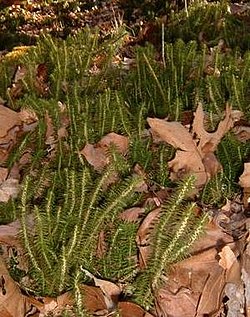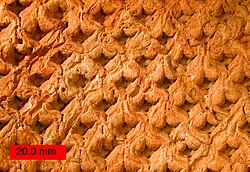Clubmoss
Clubmosses are a group of plants in the Lycopodiophyta, which are the most ancient group of land plants. The clubmosses are an order Lycopodiales, (or a subclass Lycopodiopsida).
| Clubmosses | |
|---|---|

| |
| Lycopodiella cernua with close-up of branch | |
| Scientific classification | |
| Kingdom: | |
| Division: | |
| Class: | Lycopodiopsida
|
Clubmosses are thought to be structurally similar to the earliest vascular plants, with small, scale-like leaves, homosporous spores borne in sporangia at the bases of the leaves, branching stems (usually dichotomous), and generally simple form.
A powder known simply as lycopodium, consisting of dried spores of the common clubmoss, was used in Victorian theater to produce flame-effects. A blown cloud of spores burned rapidly and brightly, but with little heat. It was considered safe by the standards of the time.
Taxonomy
The group is now split into two families:
- Lycopodiaceae: the typical clubmosses. Their spores are on a club-like structure. Their typical chromosome count is n=34.
- Huperziaceae: the firmosses. Their spore-bearing structures are in the axils of unmodified leaves. The family has a basal chromosome count of n=67.
Clubmoss Media
External impression of Lepidodendron from the Upper Carboniferous of Ohio
Axis (branch) from Archaeosigillaria or related lycopod from the Middle Devonian of Wisconsin



